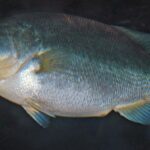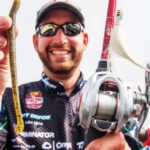Editor’s Note: There’s no question that tackle does make a difference. New innovations, depth finders, lures, rods, reels and other equipment are allowing professional fisherman to catch as many or more bass than they have in the past. One of the most-consistently successful pros is Ott DeFoe, winner of the 2019 Bassmaster Classic and ranked third in the world, with earnings of $2.7 million according to BassFan (http://www.bassfan.com/). Ott DeFoe explains that, “The equipment that bass fishermen use are tools. To be the best you can be, you’ve got to use the best tools for every fishing condition that you’ll face when on the water. A carpenter won’t use a tack hammer to drive a tenpenny nail or a big hammer to drive a finishing nail. So, over the years, fishermen have learned which equipment is best to use when fishing certain lures under specific conditions to get bass in the boat. This is the reason different lengths and types of rods are needed for various kinds of lures and places where we fish those lures.” To learn more about Ott, visit his Facebook page at https://www.facebook.com/ottdefoe/.
 Gear Ratios: Some reels seem to have more gear ratios than an 18-wheeler. The reason for the different gear ratios is dependent on the lures I’m fishing, and how fast or slowly I want to retrieve my lures. Today I only carry three different gear-ratio reels on my bait-casting equipment. I use a 6.8:1, a 7.5:1 and an 8.3:1.
Gear Ratios: Some reels seem to have more gear ratios than an 18-wheeler. The reason for the different gear ratios is dependent on the lures I’m fishing, and how fast or slowly I want to retrieve my lures. Today I only carry three different gear-ratio reels on my bait-casting equipment. I use a 6.8:1, a 7.5:1 and an 8.3:1.
a) 6.8:1 Reel – I like to fish all my treble hooks on a 6.8:1 gear-ratio reel. I not only use that reel for my crankbaits, but also for top-water lures, swimbaits and hair jigs. I think I have more of a feel for the lure as I’m retrieving it with a slower gear-ratio reel. I know how fast I’m turning the handle relates to how fast the lure is moving in the water. I want to know that I’m not overpowering the bait by reeling it too fast. With that reel, I can slow the bait down or speed it up. For me, the reel with this gear ratio is my best reel for letting me know the speed of the bait, and what the bait is doing under the water.
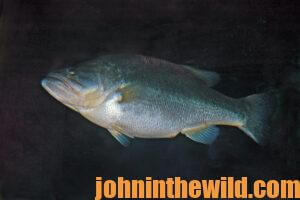 b) 7.5:1 Reel – With my 7.5:1 gear-ratio reel, I like to use this reel when I’m fishing single-hook lures like a buzzbait, a spinner bait, bladed jigs and a frog. This reel allows me to fish baits a little faster than my 6.8:1 reel does, and many times when fishing these types of lures, the bass will take the bait and keep swimming toward you. So, you have to take-up line fast to get a good hook set and not have slack in your line.
b) 7.5:1 Reel – With my 7.5:1 gear-ratio reel, I like to use this reel when I’m fishing single-hook lures like a buzzbait, a spinner bait, bladed jigs and a frog. This reel allows me to fish baits a little faster than my 6.8:1 reel does, and many times when fishing these types of lures, the bass will take the bait and keep swimming toward you. So, you have to take-up line fast to get a good hook set and not have slack in your line.
c) 8.3:1 Reel – With many lures, reel speed determines how the bait acts, how fast it’s moving, and how fast you’ll get the bass to the boat. But with the 8.3:1 gear ratio reel, I’ll be working the lure with the rod tip and giving the lure action with the rod tip instead of the reel. With the 8.3:1 gear-ratio reel, I’ll mostly be fishing soft plastics and jigs. I’ll cast the bait out and move the lure along the bottom, through the cover and/or over the top of the cover with the rod. When the bass attacks, I’ll use the reel to take-up slack quickly, so I can set the hook.
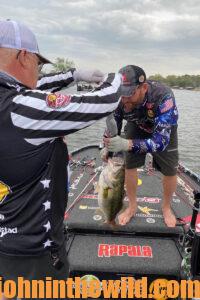 d) General Information on Gear Ratios – When I’m using a spinning reel, I like a reel that’ll take line up quickly – probably a 6.2:1 gear ratio reel. I like this reel on my spinning rod for many of the same reasons that I prefer the 8.3:1 gear ratio reel my on bait-casting reel. When I’m fishing light line and little lures, I’m primarily going to work those lures with my rod tip, instead of the speed of my reel. The main way I use my reel is to take-up line quickly when the bass inhales one of my little lures and sets the hook. I am mainly fishing soft plastics when I’m using the spinning reel. Also, I’ve learned that when I set the hook on small plastic lures, the bass often will take the bait and run straight toward the boat. So, I need a reel that will pick-up line quickly
d) General Information on Gear Ratios – When I’m using a spinning reel, I like a reel that’ll take line up quickly – probably a 6.2:1 gear ratio reel. I like this reel on my spinning rod for many of the same reasons that I prefer the 8.3:1 gear ratio reel my on bait-casting reel. When I’m fishing light line and little lures, I’m primarily going to work those lures with my rod tip, instead of the speed of my reel. The main way I use my reel is to take-up line quickly when the bass inhales one of my little lures and sets the hook. I am mainly fishing soft plastics when I’m using the spinning reel. Also, I’ve learned that when I set the hook on small plastic lures, the bass often will take the bait and run straight toward the boat. So, I need a reel that will pick-up line quickly
Reasons You Don’t Land Bass with Your Equipment: Most fishermen either set their drags too tightly or too loosely, or don’t set their drags at all. Each time I pick the rod I’m going to fish with, I check the drag system before I start fishing. I just take hold of the line and pull it to see how tight or lose my drag is because I want to know that that line is coming off the reel the way it should when the drag is engaged. Also, throughout a day of fishing, I’ll give the line a little tug to make sure the drag hasn’t tightened-up or loosened-up. Once you get in the habit of checking your drag system throughout the day, testing the drag isn’t a hassle. There’s no exact science as to how tight or lose your drag should be. I just use the feel test to make sure my drag is set the way I want it to be. I generally set my drag just a little bit tight, so that when I get a bite, I can set the hook fairly hard. However, if I have a big fish, I’ll loosen the drag slightly when I’m fighting the bass.
 Another reason that many bass fishermen lose bass is because they’ll let the fish jump. When a fish is in the air, there’s slack in the line, and the bass can throw many of the lures it has in its mouth. To solve this problem, I use my boat. I learned many years ago that when a fish first takes a bait, I need to have my trolling motor high to keep the bass away from the boat. When a bass swims underneath your boat and possibly jumps to the other side of your boat, you have very little control of it. When the bass is jumping, flipping and rolling right beside the boat, you also have little control over the fish. But if you use the boat to pull the fish away from the boat, then it can’t jump. You can play the bass down, and landing it is much easier. I like to drive the boat away from the fish, until I tire the bass out and then attempt to put it in the boat. This tactic makes sure I keep a tight line on the bass until I pick it up and put it in the boat.
Another reason that many bass fishermen lose bass is because they’ll let the fish jump. When a fish is in the air, there’s slack in the line, and the bass can throw many of the lures it has in its mouth. To solve this problem, I use my boat. I learned many years ago that when a fish first takes a bait, I need to have my trolling motor high to keep the bass away from the boat. When a bass swims underneath your boat and possibly jumps to the other side of your boat, you have very little control of it. When the bass is jumping, flipping and rolling right beside the boat, you also have little control over the fish. But if you use the boat to pull the fish away from the boat, then it can’t jump. You can play the bass down, and landing it is much easier. I like to drive the boat away from the fish, until I tire the bass out and then attempt to put it in the boat. This tactic makes sure I keep a tight line on the bass until I pick it up and put it in the boat.
Although every professional angler uses different types of tackle and various strategies for the equipment he uses, this is what I use, the way I fish, and the way I’ve been successful. I hope what you’ve learned will help you, and I hope you use some of the same strategies that I’ve found works for me. Good luck my friends! And, if you get to come to any of the Major League Fishing tournaments, be sure to look me up. I’ll try to help you in any way I can.
Fall Bass Fishing Secrets – https://youtu.be/lr_eylTAEzE
Best Locations for Fall Bass Fishing – https://youtu.be/O6uiMSj7Ac4
Ott DeFoe – https://www.youtube.com/watch?v=R009agktUWw
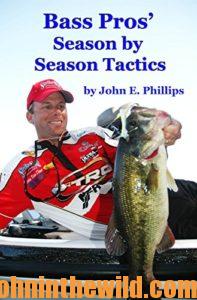 To learn more about catching bass, check out John E. Phillips’ book, “Bass Pros: Season by Season Tactics,” available in Kindle, Audible and print versions at https://www.amazon.com/gp/product/1987482832/ref=dbs_a_def_rwt_hsch_vapi_taft_p7_i4
To learn more about catching bass, check out John E. Phillips’ book, “Bass Pros: Season by Season Tactics,” available in Kindle, Audible and print versions at https://www.amazon.com/gp/product/1987482832/ref=dbs_a_def_rwt_hsch_vapi_taft_p7_i4
You may have to copy and paste this click into your browser. When you click on this book, notice on the left where Amazon says you can read and hear 10% of the book for free. On the right side of the Audible page for this book and below the offer for a free Audible trial, you can click on Buy the Audible with one click.








